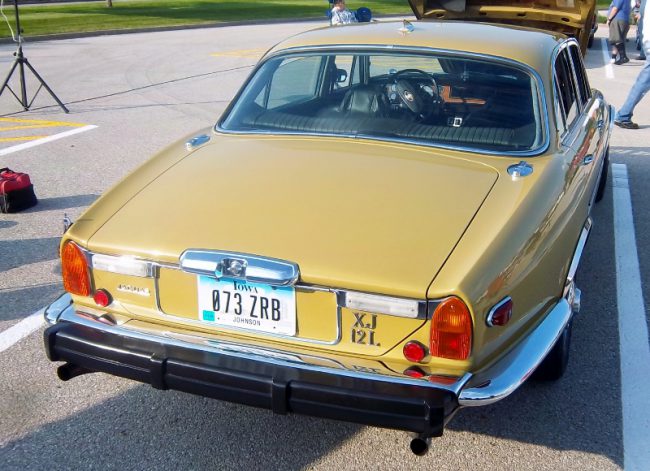
Yes, the ’70s Jaguar! Pick a model, any model. They are the Rodney Dangerfield of Jaguars. Cool. Classy. But buy one? Drive one? Insure one? Ye gods! No! Never mind other makes and models. To hear some tell it, the ability to keep an XJ12 running requires a combination of skill, money, spit, baling wire, more money, Lucas factory-original smoke, and–you guessed it!–more money! And also, money. And some more. And then, even with serious commitment, it might run for two or three days before something else craps out, requiring another week in the shop and $1000 cash injection. At least, that is the word on the street and on the web. And ya know, you can trust the internet! A guy on Facebook told me so!
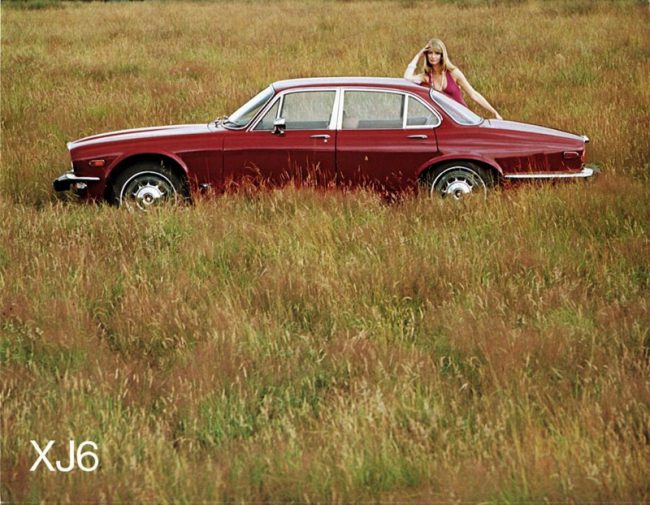
1974 Jaguar XJ6. Pure class.
If true, it is a shame, as the original Jaguar XJ6 and XJ12 were absolutely beautiful cars, inside and out. Even the larger bumper guards added to 1974 and up U.S. models didn’t detract from its elegant lines. Could it be the most beautiful sedan ever built? I think so…
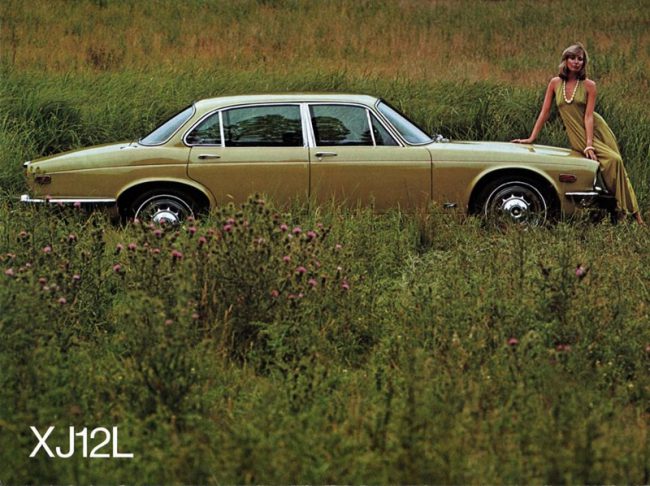
The XJ12 debuted in mid-1972. Initially, both standard-wheelbase and long-wheelbase versions were offered. LWB models got an extra four inches, all of it in the rear compartment, as can be seen in the two pictures above of a red XJ6 and a tan XJ12 L sedans from the 1974 U.S. brochure. And by the way, why can’t new car brochures have beautiful photography like this? It seems most car brochures over the past decade show a gray car in a gray background with just the hint of the driver’s head behind the wheel–if indeed any human being is included in the picture. Borrrr-ring! But I digress.
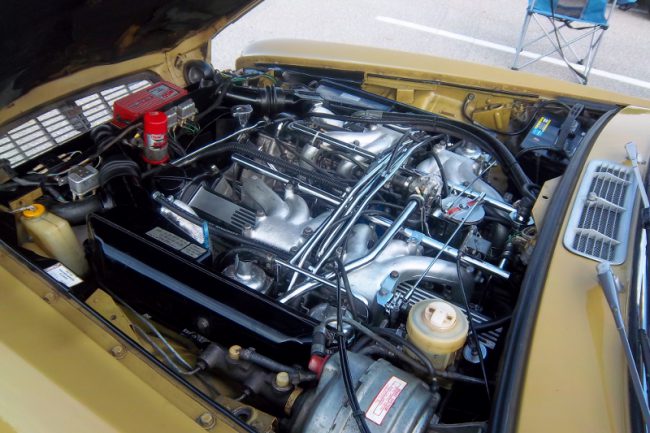
The XJ12 and XJ12L featured the same 5.3 liter aluminum engine as first seen in the 1971 E-Type V12 model. Brakes and tires were both beefed up over the six-cylinder model. An SI V12 took 7.4 seconds to sixty and 19 seconds for zero to one hundred miles per hour, but that was likely for the home-market version in Blighty, not the emission-spaghettied U.S. model. Fuel efficiency was unsurprisingly lacking with 11 mpg being the average. Total production of the SI XJ12 was 2,474 standard wheelbase models and 754 XJ12Ls.
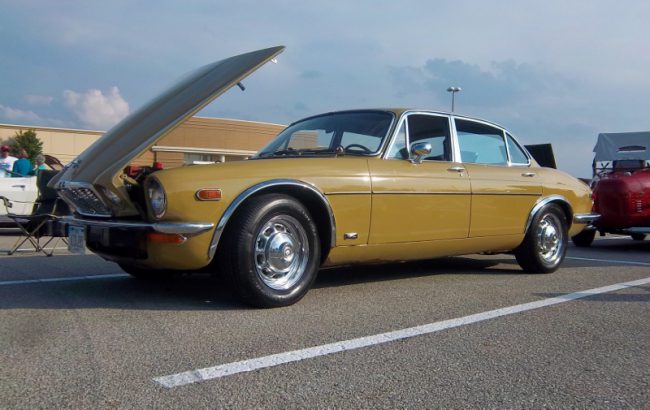
The Series II XJ sedans made their appearance in September 1973. Whether equipped with the six or the V12, all cars received a higher front bumper and shorter grille to comply with new U.S. bumper regulations. A new instrument panel and redesigned heating and air conditioning system and padded steering wheel were also added, among other things.

The Series II XJ12 L had a total length of 195″, with a wheelbase of 112.75″. The home market V12 developed 285 bhp at 5750 rpm and 294 lb-ft at 3500 rpm. Zero to sixty was accomplished in 7.8 seconds, with a claimed top speed of 147 mph. The de-smogged US version made 244 hp at 5250 rpm.
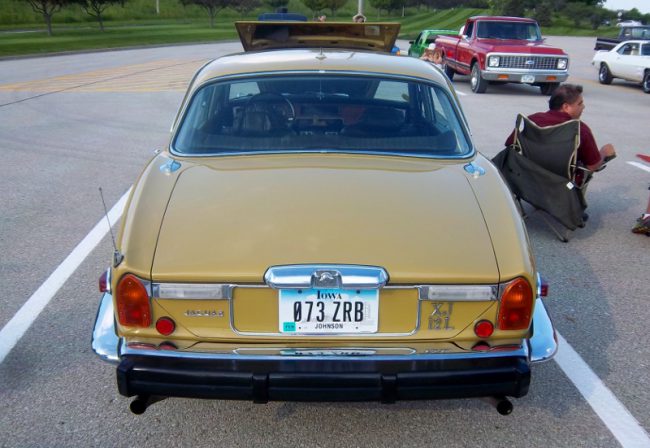
While the XJ6 was no slouch itself, the primary goal of the V12 version was silence, smoothness and refinement. It was also a very complicated engine, with twin camshafts, twin fuel pumps, four Stromberg carbs and Lucas Opus electronic ignition. Beginning in 1975, it was fitted with Bosch-Bendix electronic fuel injection. Though the XJ had been designed with a V12 in mind, it was still a bit of a tight fit, and a very Rube Goldberg-like radiator, divided into two separate sections with feeder tanks on either side. Even the battery received its own cooling fan!
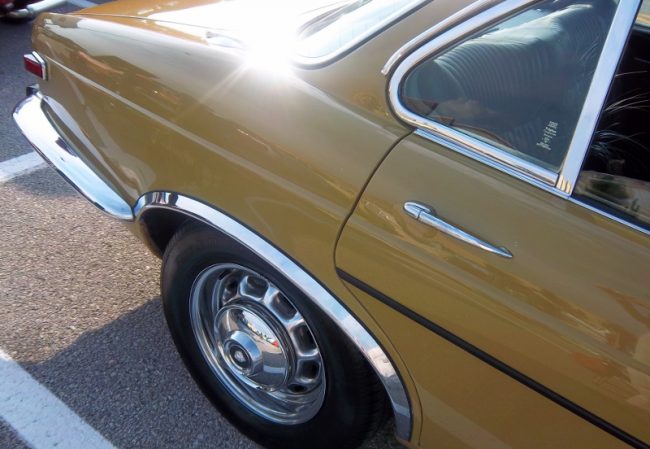
As you might expect, all of this complicated engineering resulted in trouble if not meticulously maintained. But considering a 1973 XJ12 L went for £4,702 new (approximately $11,400 in 1973 dollars), who wouldn’t? But the trouble came for the second, third and fourth owners. Defer maintenance at your own peril!
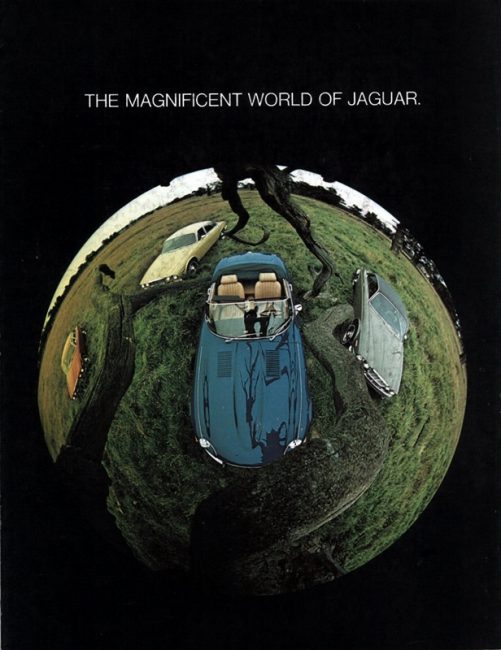
But the truth of the matter is, even when brand new these cars, despite their cost, luxuries and amazing engineering, were still a product of BL, with workers who may or may not have cared to do their best on any given day. So, even the owner of a brand-new XJ12 L–let’s call him Reginald T. Haversham-Fairthorpe III–could have had paint, assembly and mechanical troubles. Add the additional complexity of a V12 engine, and who knows what could happen. But obviously I have no experience with ’70s Jags when new–perhaps some of our readers can enlighten us?

But they were so pretty! Look at that beautiful wood dash! Plush leather! Snazzy roofline and oh-so-swoopy coachwork! Wouldn’t you love to go for a ride in this car, sitting in that leather-lined rear seat with ample stretch-out room, while nursing a gin and tonic and browsing the Daily Telegraph? I would!
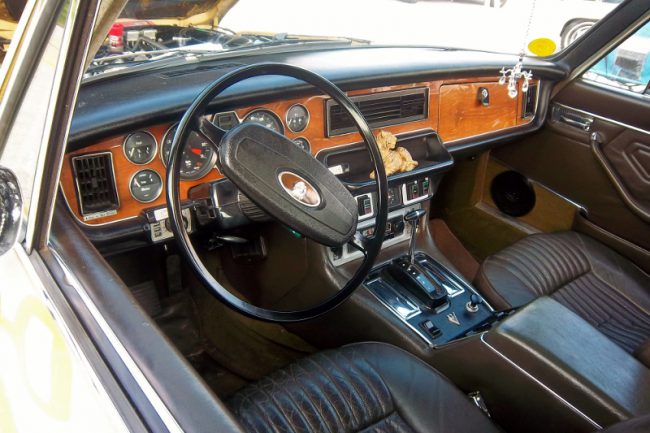
I just love the interiors on these cars. I daresay that ANY Jaguar interior is a most pleasant place to be. Comfy seats, that oh-so-delicate gear selector, lovely wood trim and full instrumentation. What’s not to like? Well, Jason Shafer may have a bone to pick with that rather large console…
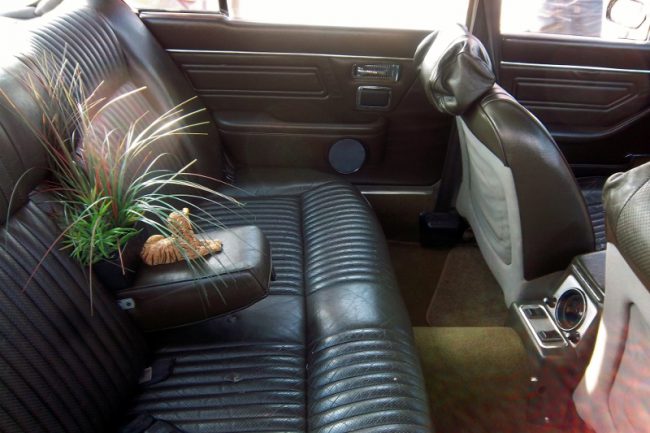
I spotted this butterscotch-hued Jag at the May 30th, 2014 Classy Chassy car club cruise-in in Coralville, Iowa. I knew even from a distance that this was something special, but as I got closer I noticed twin cylinder banks instead of one. Egad! ‘Tis not a relatively common mid-’70s XJ6, but an XJ12 L!
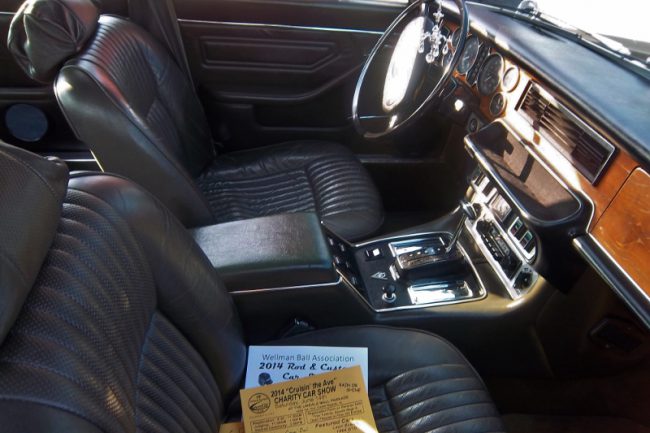
Indeed it was. It was a real thrill to check out this car in person. I have never, ever seen one of these in the metal. I was just smitten with its condition and striking originality.
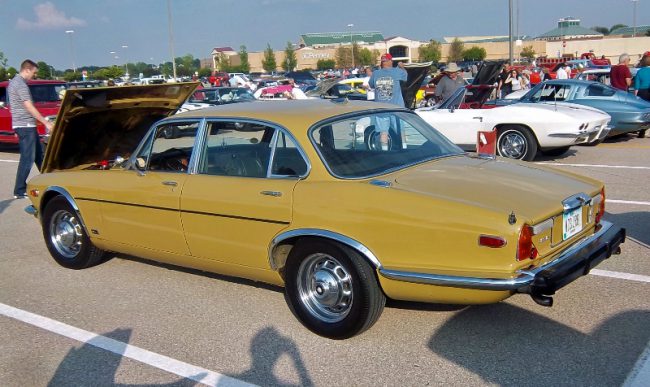
I spoke with the owner, and he confirmed it is a real V12, and that he and his brother were able to get it running. I have to give them a MAJOR thumbs up for getting such a neat, uncommon and undoubtedly complex vintage car running, to take to shows and just plain enjoy.
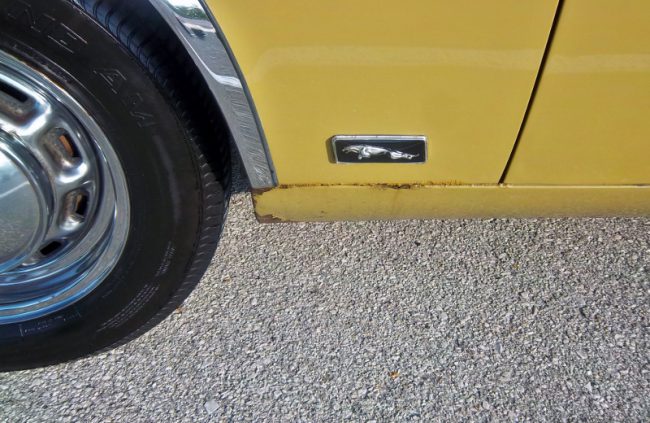
Naturally, there’s some wear, and some surface rust. But that just adds to the patina. With so many over-restored old cars at shows and cruise ins these days, it’s a breath of fresh air to see a nice original.
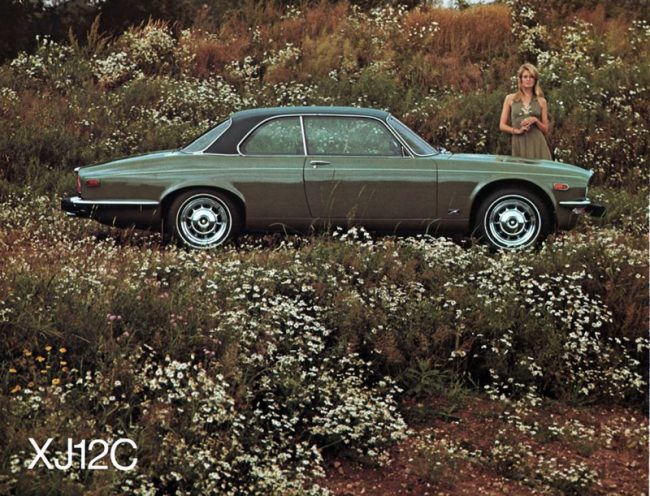
And if the sedan doesn’t float your boat, the V12 was also available in the gorgeous XJ12C coupe. Good luck finding one of those, though. They appear from time to time, but production was minuscule compared to the sedans.
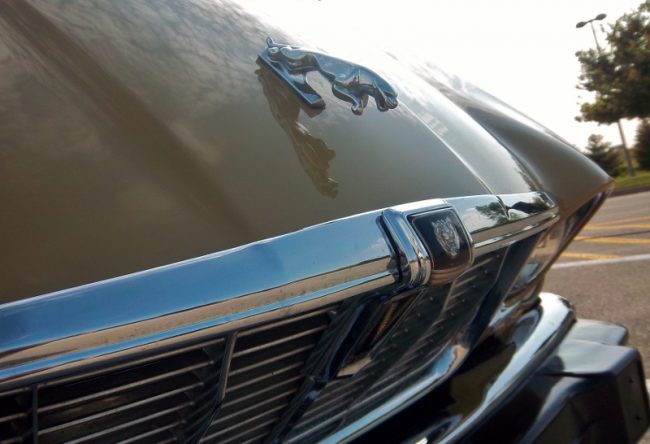
According to my 1974 Jaguar brochure, the U.S. XJ12 L featured twin SU fuel pumps, Opus Mark II electronic injection, four wheel disc brakes, dual 12-gallon fuel tanks (sound familiar, Keith?), four Zenith-Stromberg carburetors, radial whitewall tires (steel-belted on XJ12s), automatic transmission and an AM/FM multiplex radio with four speakers. 244 hp. I wonder how much the emissions add-ons affected performance?
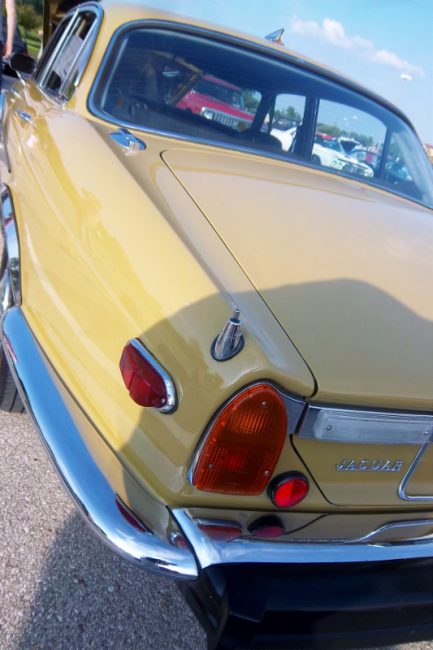
Ah, who cares! When you’re rolling down the boulevard in your beautiful XJ12, Ray-Bans in place, with the factory speakers belting out “Hotel California,” with no particular place to go, who cares about negative minutiae like that. Who wouldn’t be proud to have this car in their garage?
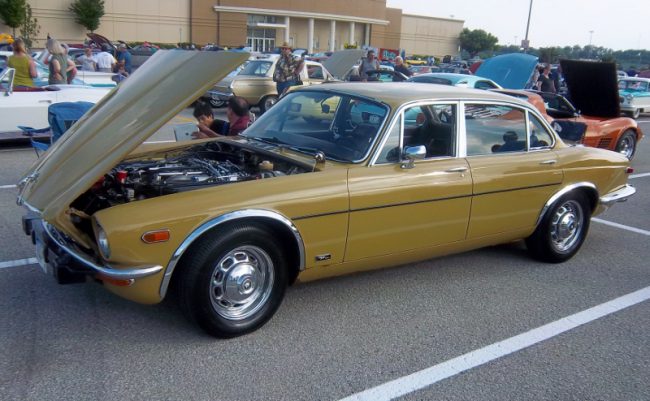

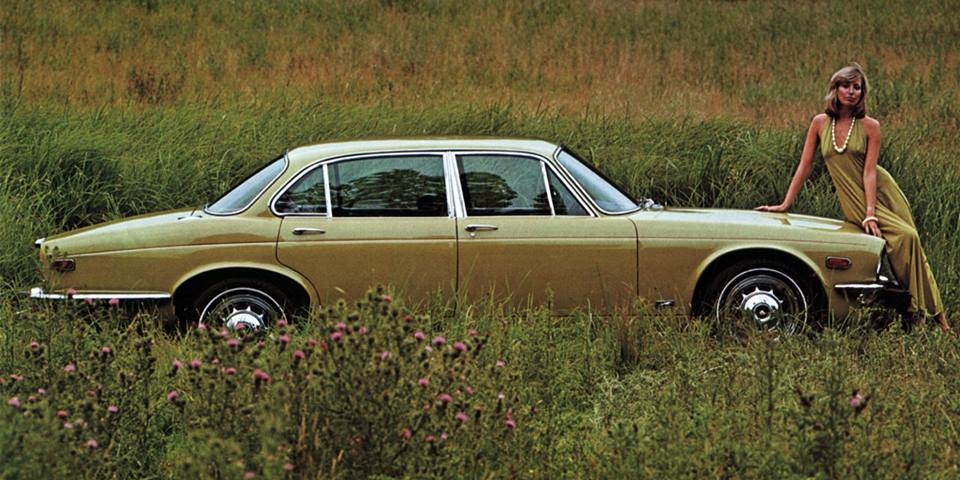
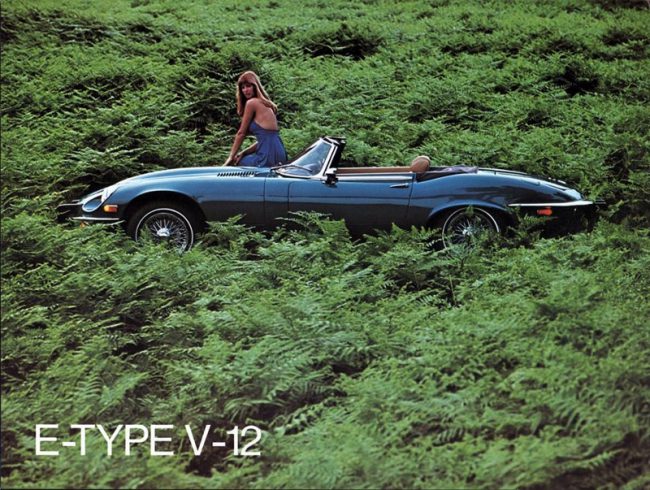






34 Comments
Best looking four door and sports car ever in my opinion. No wonder Queen Elizabeth Knighted the stylist. With both the W116 and the W126 the NVH benchmark that Mercedes strived for was the Jaguar XJ. In both cases they admit they fell short.
Jaguar had the bizarre stigma at the time of being built by the Allies instead of the Axis. As a result, they had to price the car too low to sell and then they had low resale. This resulted in a very complex car falling into the hands of people that couldn’t afford to have the dealer keep them in good shape.
The dealers really didn’t do a good job of keeping them in good shape either……somethings are just subject to inherent vice…..no matter what you do, it will deteriorate.
The joke of the time was that owning a Jag gave extra status because you needed to buy two in order to have some chance that one would running at any given time. The problem with Jaguar was they always gave you much more technical sophistication and luxury than the price could support, so they always cut corners on components and assembly quality that didn’t hold up very well or long in ordinary use. Throw in strike/sabotage prone union workers, ancient plant and machinery, and it is a wonder that 1970s era Jags ran and drove at all, but nothing looked better sitting on the side of the road dripping oil and coolant.
Always buy Axis, so says Stingray.
Actually John, as my handle implies I was the happy owner of a St. Louis built 1965 Sting Ray for 11 years. I also had pleasant experiences with a 1964 Austin Healey 3000 for a couple of years, as it always broke down in the most convenient way possible (i.e. close to civilization and easy DIY fix). I greatly enjoyed my experience with a 1987 Honda CRXsi, which lived up to its Japanese reputation by never breaking down while needing minimal maintenance, although its interior quality and suspension travel were marginal. But you are also partly correct, because the best all around cars I have ever owned were both German, my BMW 2002 and e30 318is.
Nice diverse selection there
You’re really effing obtuse sometimes John. That’s not what he’s saying.
He’s merely pointing out factual realities. British manufacturers of the era DID cut corners (penny wise, pound foolish and all that..) and they DID have shithead union lifers sabotaging everything in a self defeating marxist crusade.
It’s hardly Stingrays – or anyone else’s – fault that ‘The Axis’ figured out how to have productive labour relations and as such ended up producing more appealing
products.
Yes I know Panzer, Jaguar really sucked, I saw it on Mad Men as well. There was another where the genius writers on that show had Honda being so into design. Of course all they were making then was mopeds but the writers were prescient. Well my side was with Roger Sterling on that show.
The XJ6 came out in 68 and it’s best sales year was 1985. Is that really a sign that they were some despicable peace of junk. The platform was shortened for the XJS and then used on the later AM DB7 and XK8 into the twenty first century. A proven design. As was the DOHC 6, and the Borg Warner and GM400 transmissions.
Yeah, that Honda really went nowhere in the motorcycle market…….
“The XJ6 came out in 68 and it’s best sales year was 1985. Is that really a sign that they were some despicable peace of junk.”
Yes, Trabant 601 sales peaked in 1989 too.
Is “Jaguar Unreliability being a giant myth” the hill you really want to die on here?
Comparable to cars of equal complexity. One advantage for example was that the V12 was designed from the ground up as such. MB and BMW V12s that would only cause orgasms around here were two inline sixes put together with two engine control systems that worked together less and less as they got old. I know that data point can’t compare to a Mad Men show written 40 years later but there you go.
You really don’t know what a data point is……or even ” a point” because that post had none.
Reliability? Just look at the women in those ads!
Anyway, here’s Whitesnake
When I was a young sailor with a monstrous re-enlistment bonus burning a hole in my pocket I perused many auto dealerships for something unique and cool. The Jaguar dealer in Pocatello had a brand-new E-Type with the ubiquitous V-12 in the showroom – powder blue, 2+2 – for a ridiculous price – about $28k in 2019 money. Beautiful car and, man, was I tempted. But I also had several buddies with vehicles from Jolly Old England (Triumphs and MG’s mostly) and a sister who had a new MG Midget (which spent more time in the service bay than on the road) and though it would be cool to own it would be a nightmare to keep running. I somewhat reluctantly passed on the Jag and went down to the Porsche dealer in Salt Lake City…
A good friend of mine in high school was the son of a dentist who had a 6-cylinder XJ in lemon yellow. Seated in the back with Kevin and his pretty twin sister for a trip to the beach, I could not tell when the engine had been started. We simply glided off in a way I have not experienced since. Glorious.
Kevin was not allowed to take it out himself until the night of senior prom, when he had waxed it by hand. The lower radiator hose blew off just a block down the road and he had to return home with his date to fetch the family’s dirty Subaru wagon. Sigh.
Lovely photos. Lovely memories…all artificial, but lovely.
I got my driver’s license in the era that was the nadir of British Leyland…where Jaguar, Rover, Triumph and MG were all foundering. The reasons were many and interlinked, but it all came down to, poor quality – and even-more poor support of the product once purchased.
In those dark days of the 1970s, MGBs were on the ground in significant numbers. Usually they were immobile. Land Rovers were not common vehicles in Cleveland, but a stray Jaguar would sometimes prowl the streets.
But they didn’t last. The few people my age who bought an MG or Triumph, soon regretted it.
Why? It wasn’t JUST poor product. Datsuns of the early 1960s were of quality about as poor – with failures and unwillingness to run in cold temperatures. The VW Beetle, which today carries its own gilded memories…it was a maintenance-hungry, difficult beast. Anyone with Vise-Grips and a screwdriver could maintain it – but easy maintenance is not necessarily low maintenance.
But those makes thrived. Why? They were INTERESTED in the customer; and interested in improvement. Britain, which basically sold Datsun their first world-class auto engine design…was stressed for capital and struggling with an entire class of blue-collar workers who wanted to destroy their own jobs. Strikes, riots, sabotage…they succeeded, as the products became shoddier and less-competitive each year.
That is the era that short-lived V-12 came into. On paper, it was brilliant. I remember a 1973 C/D write-up about the XJ12…this was in the era where David E. Davis had been fired and not-yet recalled; and the unsigned review just dripped of puffery. But those cars never caught on, in the States – so long as Jaguar and Rolls were the luxury standards, Cadillac and Lincoln were competitive alternatives and better buys.
It’s a wonderful specimen, and of a car of which I would bet there’s only two-digits’ worth surviving. But to go back there? In that car? No. Just, no.
My had a 72 E-type V12 and a small fleet of other little British cars. I remember well it’s unreliability. I began collecting cars (mostly British) about 10 years and I can say thanks to the internet and years of built up knowledge all these things can be made reliable. It’s far easier to own a E-type today than it was 20 years ago. I looked for one last Spring but couldn’t find a decent driver quality E for less than 65k. I ended up picking up a Morgan plus 4, 2 seater instead. The original XJ perhaps prettiest sedan ever made, like almost every four car ever made doesn’t have enough market value to justify proper maintenance, let alone restoration.
In high school I had a Spitfire, which threw a rod when I took it out on the highway and foolishly took it up to 65mhp. So then I had two Spitfires, one for parts and one that usually was not running.
It was so much fun in the summer with the top down, but those good times were few and far between. My parents were not pleased about these two pieces of junk taking up garage and driveway space, they were towed away when we moved.
My cousin has money and desires status, she leases a 2018 XJ. It took a shit on the highway last fall with 4,000 miles on it.
My dad bought a 1964 E-type coupe brand new. I have many happy memories, talking with dad as we waited for a tow truck. After two years of ownership, he crashed into a tree. Dad said it was a blessing from god. My buddy, Jeff, bought an XJ-6 brand new. It was constantly in the shop. He sold it to his mechanic. So, yes, Jaguar rightfully earned its bad reputation. And dad? He bought Toyotas and Ford trucks for the rest of his life. He never bought another Jag (or any other British car) and seemed happy with that decision.
We hear from the comments what a challenge British Leyland had moving the metal in the 70s. Workers often struck, wanting more pay and their bought and paid for Labour politicians to represent them instead of the people on the dole that seemed their real concern. It was also the time at home where buying BL meant supporting ones country in a way that did not appeal to that generation.
That does not mean there were not world class designers innovating while the others merely copied. Here is some of the models that deserved more success than they had.
Morris Metro, hatchback supermini with hydrolastic suspention for better ride than the other guys struts
Austin Alegro Golf sized FWD with hydrolastic suspension and improved on it’s predessesor by a larger ohc engine teamed with a 5sp for relaxed motorway travel. Wood leather and picnic tables a unique offering in class.
Princess Wedge FWD Citation sized with hydrolastic suspension and transverse mounted ohc inline fours and ohc sixes. Wood, leather, and picnic tables available
Triumph Dolomite light RWD sport sedan with dohc 16 valve engine and 7 speed transmission. Wood and leather available
Rover SD1 large versatile hatchback with ohc 4, two ohc 6s, a diesel or an injected aluminum V8. 5 speed, Wood and leather available
Jaguar, sales only got better over the 24 year run as people realized what a treasure it was at such value for money.
Range Rover aluminum, long travel suspension, V8 or diesel, 2 door only early thast enhanced credibility by having the nobleman drive himself on their offroad empire excursions
There are others but you get the idea. There was talent, producing uniquely British offerings in the era before all cars going metoo.
Most of those innovations predated the combination into British Leyland, and subsequent nationalization of the hodgepodge conglomerate.
And one could see the innovations were quickly reducing to a trickle. The Mini was a brilliant first-stab at a city car, true. The Austin engine was top-notch engineering of its time – which was why Nissan sought licensing for their postwar cars.
But it decreased. Land-Rover was a Jeep knockoff, and not done so well, from an aesthetic viewpoint. Depending on who you ask, it’s better offroad, but it lacked the clean packaging and utter minimalism of the first CJs. The Range Rover V8 was, of course, the castoff Buick design. Rover made it work where the General couldn’t; but part of that might be the differing expectations by each company.
Modernizing the MG Midget and MGB, to comply with Federal regulations…showed how few resources, talent and money, BL had to draw on. And their last hurrah, the Triumph TR7/8…after considerable enthusiasm, it came out as unreliable and poorly assembled as anything else from BL. AND, the chaos backstage, where the assembly line was moved twice, while the hardtop was dropped in the chaos…it was reminiscent of Packard’s final flailing years.
My examples above centered around 1979 right before the BL Edwardes metoo farmout and copy era. What car maker outside the worldwide offerings of the big three had such a modern full line. Toyota, no FWD. Nissan, no still waiting for their first inhouse engine. Honda, only FWD and nothing bigger than 1.8 liters and no automatic with more than two gears. Fiat, no big cars. Renault, old too small engines. VW no trucks or bigger cars or any ability to combine a front engine with RWD. Yet who got no respect in the car world, the big three and British Leyland. Politics and ignorance.
What you described was, each company focusing on its strengths.
VW isn’t Daimler-Benz. It has a different corporate culture and history; and has neither the customer expectations nor engineering experience to create large, heavy RWD cars.
Nissan isn’t Toyota and neither are Subaru. Each has their own background.
British Leyland was a hodgepodge…merged together for political reasons. All the component companies were in trouble and the Labour government was not willing or able to see bankruptcy and liquidation. So, they brought them all together…the totality of them was even less than the sum of the parts. And, then…like the Penn Central Railroad in the States…when politically-driven merger failed, the mess was nationalized.
You take your shots on the Asian brands. Well, they all came from humble roots – Nissan made Austin engines for decades; Honda was a bicycle shop owned by an energetic, ambitious mechanic. I had a 1979 Datsun PL620 pickup, and it was one of the best vehicles I ever owned. Certainly the best light truck I’d ever driven. It was not sturdy like a Chevrolet of the time, but as a suburban homeowner’s tool, it was more than adequate. And as a car/truck dual-purpose vehicle, it was better than owning both. Austin engine, so what!…Nissan made it liveable and reliable.
Toyota is the stogy old man of the Japanese manufacturers. Yes, they were last-out-best-dressed with FWD. This of course is changing, as they were the innovators with hybrid drive…that, too, is to be expected. Like people, businesses change their nature over time.
But I see little to recommend British vehicles besides their long-past history. As standalone companies, they were failing. As a state-created monopoly, they did fail. As divisions of foreign automakers, they didn’t pay enough to their owners that Ford wanted to keep them. Their domestic market is small, due to hyperregulation at home, heavily-taxed petrol, and stagnant levels of disposable income.
It’s over. They had a great past, but so did Rome and Sumer have a great history.
I work with a Jaguar fan and owner, so this man has some genuine skin in the game. The story below is from memory (mine) of what he told me.
The XJ sales started to improve once the company put in place a Managing Director that was serious about the quality of the product. It was not an easy or rosy path, as the company almost died, but eventually as they got the quality of the cars better, sales started to improve.
Then, Ford bought the company. And Jaguar used Ford’s product development system, making the cars even better.
The British have designed brilliant cars, but the quality wasn’t there, in some case due to cost compromises, in others because the technology was not mature enough at the time in some others because sometimes their product planning was disastrous.
Such is life.
Athos – your story corresponds well with what I have heard from several sources. Jag sales in the 80s went up because the cars were finally of decent quality, while the beautiful styling and technical specifications were still class leading (although basically unchanged since the late 60s).
The universality of the Jaguar reputation for unreliability was never better staged than Season 5, Episode 12 of “Mad Men”, when Lane Pryce was caught embezzling, was “resigned” and went home to commit suicide. He chose to asphyxiate himself by running his new XKE in the small garage. He sealed the garage, got behind the wheel and…it wouldn’t start!
He didn’t seal the garage though, he ran a hose from the exhaust pipes to the drivers window, ready to do the deed, in true British fashion, he broke his glasses(not going to need them where he’s going) and he hit the starter, only to find the new Jaguar (that his wife bought with a bad check) wouldn’t start, he fumbles around under the hood for a few minutes, while holding his now broken glasses to his eyes and then he decides to head to the office to find a more reliable way to off himself.
Carmine,
Either way, the look on his face (well played by Jared Harris) was (no pun) priceless. Talk about a bad day.
It was a great “I just can have anything go my way” scene…….the episode was harsh though, as I really felt sorry for Lane and the image of his grayish purple face hanging from the rope is still kinda haunting.
During the whole “Jaguar Debacle” there was another comment about Jaguar reliability by SCP patriarch Burt Cooper, where he says “they’re lemons…..why do you think they come with a tool kit”
Yeah, that scene with Lane hanging off the back of his office door was pretty extreme. I liked the character. At the time I kinda hoped the failed attempt in the car would make him come to his senses, but nope…
Could it be the most beautiful sedan ever built?
No, that would be the Pininfarina designed Series III XJ. There is no bad looking XJ but the Series III is the best.
I once asked Sergio Pininfarina about that car and he was very modest about it, saying he was workign with an already beautiful car.
He did manage to get a little more rear headroom without ruining the roofline. Just miles better than for example the Peugeot 604 around the same time that offered Sergio a blank sheet of paper.
The Series III roof is right up there with the pagoda Mercedes-Benz models.
One of my coworkers has a V12 E-Type. That engine is a sight on itself.
The packaging of everything under the bonner is magnificent. Tight as it is, there is a place for everything with relatively easy access. Some service operations are specialized, but nothing outside a good mechanic’s set of skills.
I have been in the car and walked away amazed. The power delivery is smooth and effortless.
He also has a X-Type, which is a wonderful vehicle, despite being much maligned by the press. Those 2 cars changed my image of the brand.